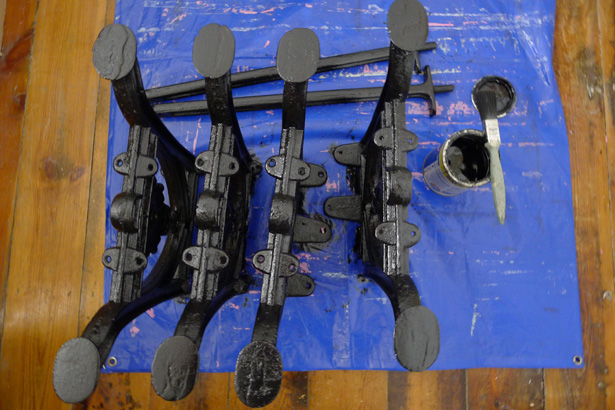
Some commonsensical practices we've learnt the roundabout way through the years hereforth laid out in short for those adventurous hackers among you. Take it or leave it:
If you are drilling anything larger than a 5mm hole in metal it is better to drill a succession of pilot holes using a range of drill bits that increase in size until you reach the required diameter.
These holes were started at 3.5mm as the 18v cordless drill is unwieldy (read "ergonomically designed for an adult male's grip and strength"). The 3.5mm drill creates less friction making it easier to keep the drill upright at 90° to the surface of the metal. Once the initial pilot hole is drilled perpendicular it is easier to keep the drill upright for all subsequent holes. We used candle wax for drilling the first hole only to reduce friction. After that, to prevent a drill from blunting you want it to cut through the metal efficiently so do not use a lubricant. The friction creates heat, a gob of spit will go a long way to cooling the drill bit and keeping the cutting edges sharp (water runs away too fast).
Sod's law your drill will snap if firstly you don't keep it perpendicular to the surface of the work and secondly you apply too much pressure on the drill - easy does it, you are a lot stronger than you think you are. Investing in cramps will pay out in savings on replacing broken drill bits. Murphy's law, you will snap more than the occasional drill bit until you develop the feel for drilling, don't be hard on yourself (it's not coincidence 3.5mm drill bits are sold in multi-packs).
Choose a higher speed setting when using a smaller diameter drill bit and a slower speed setting for a larger one.
The swarf is sharp so wear eye protection.



Wire-brushed and painted with direct-to-rust paint.

Shout out to our local ironmongers ♥ W.P Wakefield Ltd.♥ 682 Lea Bridge Rd, London, E10 6AP. Where, unlike Big DIY, there is no packaging and you can buy the exact number of fixings you require, reducing waste.

Holes are pre-drilled before screwing in the coach screws to prevent the plank from splitting. A rule of thumb to find out which drill bit diameter to use for pre-drilling hold the length of the drill bit to the length of the screw. If you are able to see the entirety of the width of the screw's thread on either side of the drill bit, the drill bit is of a suitable size. If the drill bit obscures the screw's threads it is too wide in diameter. Apply candle wax to the screw threads to reduce the effort of driving in the screws.

Since we upcycled the parts of a couple of old pews, the ergonomics of the assembly was optimised by lashing the pieces together, sitting back and adjusting for comfort before fixing them together (the devil is in the detail).

We'd had an idea to use U-bolts, to attach the backrest planks to the back supports, but couldn't find any of convenient dimensions. John Bayley, the owner of W.P. Wakefield, helped us find an alternative solution, of a plate nut drilled with two threaded holes that could be bolted through to clamp the planks to the supports, which worked a treat.

Ta-da, here's the one we made earlier by our own fair hands. Kitteh-approved despite it looking a little like a strandbeest.










































